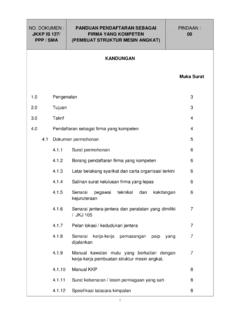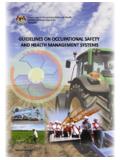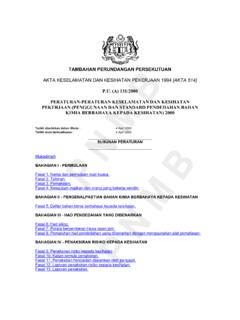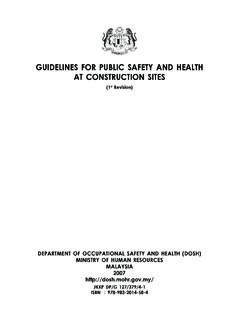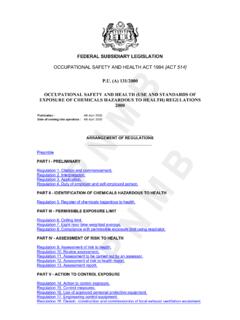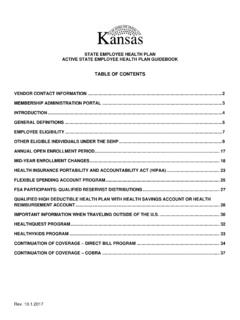Transcription of P.U. (A) 131/2000 OCCUPATIONAL SAFETY AND HEALTH …
1 FEDERAL SUBSIDIARY LEGISLATION OCCUPATIONAL SAFETY AND HEALTH ACT 1994 [ACT 514] (A) 131/2000 OCCUPATIONAL SAFETY AND HEALTH (USE AND STANDARDS OF EXPOSURE OF CHEMICALS HAZARDOUS TO HEALTH ) REGULATIONS 2000 Publication : 4th April 2000 Date of coming into operation : 4th April 2000 _____ ARRANGEMENT OF REGULATIONS _____ Preamble PART I - PRELIMINARY Regulation 1. Citation and commencement. Regulation 2. Interpretation. Regulation 3. Application. Regulation 4. Duty of employer and self-employed person. PART II - IDENTIFICATION OF CHEMICALS HAZARDOUS TO HEALTH Regulation 5. Register of chemicals hazardous to HEALTH .
2 PART III - PERMISSIBLE EXPOSURE LIMIT Regulation 6. Ceiling limit. Regulation 7. Eight-hour time-weighted average. Regulation 8. Compliance with permissible exposure limit using respirator. PART IV - ASSESSMENT OF RISK TO HEALTH Regulation 9. Assessment of risk to HEALTH . Regulation 10. Review assessment. Regulation 11. Assessment to be carried out by an assessor. Regulation 12. Assessment of risk to HEALTH report. Regulation 13. Assessment report. PART V - ACTION TO CONTROL EXPOSURE Regulation 14. Action to control exposure. Regulation 15. Control measures. Regulation 16. Use of approved personal protective equipment.
3 Regulation 17. Engineering control equipment. , 19. Records of engineering control equipment. PART VI - LABELLING AND RELABELLING Regulation 20. Duty of employer to ensure labelling. Regulation 21. Relabelling. PART VII - INFORMATION, INSTRUCTION AND TRAINING Regulation 22. Information, instruction and training. Regulation 23. Information, instruction and supervision of person. Regulation 24. Chemical SAFETY Data Sheet. Regulation 25. Provision of Chemical SAFETY Data Sheet in a place of work. PART VIII - MONITORING OF EXPOSURE AT THE PLACE OF WORK Regulation 26. Monitoring of exposure.
4 PART IX - HEALTH SURVEILLANCE Regulation 27. HEALTH surveillance programme. PART X - MEDICAL REMOVAL PROTECTION Regulation 28. Medical removal protection. PART XI - WARNING SIGN Regulation 29. Warning sign. PART XII - RECORD KEEPING Regulation 30. Retention of records by employer. SCHEDULE I SCHEDULE II SCHEDULE III Preamble In exercise of the powers conferred by section 66 of the OCCUPATIONAL SAFETY and HEALTH Act 1994 [Act 514], the Minister makes the following regulations: PART I - PRELIMINARY Regulation 1. Citation and commencement. (1) These regulations may be cited as the OCCUPATIONAL SAFETY and HEALTH (Use and Standards of Exposure of Chemicals Hazardous to HEALTH ) Regulations 2000 .
5 (2) These Regulations shall come into operation on 4 April 2000 . Regulation 2. Interpretation. In these Regulations, unless the context otherwise requires - "airborne concentration" in relation to a chemical means the quantity of a chemical measured in terms of its volume or its mass in a specified volume of air or the number of fibres, if the physical form of the chemical is fibrous, in specified volume of air which is carried by or through the air; "approved" means approved in writing by the Director General; "assessor" means an employee or any other person appointed by the employer and registered with the Director General to carry out assessments of risks to HEALTH .
6 "ceiling limit" means the airborne concentration that should not be exceeded during any part of the working day; "chemicals" means chemical elements, or compounds or mixtures thereof, whether natural or synthetic, but does not include micro-organisms; "chemicals hazardous to HEALTH " means any chemical or preparation which - (a) is listed in Schedule I or II; (b) possesses any of the properties categorised in Part B of Schedule I of the OCCUPATIONAL SAFETY and HEALTH (Classification, Packaging and Labelling of Hazardous Chemicals) Regulations 1997 [P. U. (A) 143/97]; (c) comes within the definition of "pesticide" under the Pesticides Act 1974 [Act 149]; or (d) is listed in the First Schedule of the Environmental Quality (Schedule Wastes) Regulations 1989 [P.]
7 U. (A) 139/89]; "Chemical SAFETY Data Sheet" means a document which contains relevant information on a chemical and is furnished in pursuance of the OCCUPATIONAL SAFETY and HEALTH (Classification, Packaging, and Labelling of Hazardous Chemicals) Regulations 1997 [P. U. (A) 143/97]; "Director General" means the Director General of OCCUPATIONAL SAFETY and HEALTH appointed under subsection 5(1) of the Act; "engineering control equipment" means any equipment which is used to control exposure of employees to chemicals hazardous to HEALTH and includes local exhaust ventilation equipment, water spray or any other airborne chemical removal and containment equipment.
8 " HEALTH surveillance" means any examination and investigations which may be necessary to detect exposure levels and early biological effects and responses, and includes biological monitoring, biological effect monitoring, medical surveillance, enquiries about symptoms of OCCUPATIONAL poisoning or OCCUPATIONAL disease and review of records and OCCUPATIONAL history; "hygiene technician" means an employee or any other person appointed by the employer and registered with the Director General to carry out any inspection, examination or test on engineering control equipment installed in a place of work or to carry out chemical exposure monitoring; "maximum exposure limit" means a fifteen-minute time-weighted average airborne concentration which is three times the eight-hour time-weighted average airborne concentration of the chemicals specified in Schedule I.
9 "medical surveillance" means the monitoring of a person for the purpose of identifying changes in HEALTH status due to OCCUPATIONAL exposure to chemicals hazardous to HEALTH ; " OCCUPATIONAL HEALTH doctor" means a medical practitioner who is registered with the Director General to conduct medical surveillance programmes of employees; "permissible exposure limit" means a ceiling limit or an eight-hour time-weighted average airborne concentration or the maximum exposure limit; "personal protective equipment" means any equipment which is intended to be worn or held by a person at work and which protects him against one or more risks to his HEALTH or SAFETY and any additional accessory designed to meet that objective; "supplier" means a person who supplies chemicals and include a formulator, a manufacturer, an importer or a distributor; "time-weighted average" in relation to airborne concentration, means an average airborne concentration over a specified period of time.
10 "use" means production, processing, handling, storage, transport, disposal and treatment. Regulation 3. Application. (1) These Regulations shall apply to all places of work which are within the jurisdiction of the Act where chemicals hazardous to HEALTH are used except chemicals which are - (a) defined as radioactive materials under the Atomic Energy Licensing Act 1984 [Act 304]; (b) foodstuffs; (c) hazardous to HEALTH solely by virtue of their explosive or flammable properties, or solely because they are at a high or low temperature or a high pressure; and (d) pharmaceutical products.
